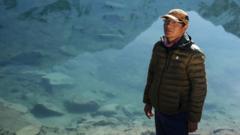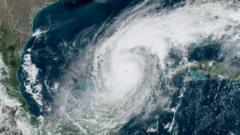A recent study underscores the grim reality that the world’s glaciers are fated to lose significant ice mass over the coming centuries, even if global temperatures miraculously stabilize. While taking steps to limit global warming can mitigate some losses, the long-term outlook remains bleak.
Glacier Meltdown: A Study Reveals Inevitable Loss of Ice Even With Temperature Stabilization

Glacier Meltdown: A Study Reveals Inevitable Loss of Ice Even With Temperature Stabilization
Research shows that glacier ice will continue to melt for centuries, regardless of immediate climate actions.
In findings released on Thursday, researchers estimate that, even if climate measures were implemented today to keep temperatures constant at current levels—an almost unattainable scenario—glaciers outside of major ice sheets would still undergo a staggering one-third reduction in mass. However, the study does suggest that rigorous climate action could save a substantial volume of glacial ice.
Environmental scientists, including Lilian Schuster from the University of Innsbruck, advocate for stringent measures to maintain global warming within 1.5 degrees Celsius (2.7 degrees Fahrenheit) above preindustrial levels. Such actions could preserve approximately double the amount of glacial ice over the next millennium compared to the current trajectory, which points toward an increase of 2.7 degrees Celsius by the year 2100.
While the vast ice sheets of Antarctica and Greenland often dominate discussions surrounding climate change—due to their potential to raise sea levels dramatically—the relatively smaller glaciers also play a critical role. Despite accounting for less than half a percent of global ice, they still contribute significantly to sea-level rise, estimated at about one foot if fully melted.
The ongoing research highlights the intricate balance of our climate system and the urgent need for concerted efforts to limit temperature increases while there is still time to affect change.
Environmental scientists, including Lilian Schuster from the University of Innsbruck, advocate for stringent measures to maintain global warming within 1.5 degrees Celsius (2.7 degrees Fahrenheit) above preindustrial levels. Such actions could preserve approximately double the amount of glacial ice over the next millennium compared to the current trajectory, which points toward an increase of 2.7 degrees Celsius by the year 2100.
While the vast ice sheets of Antarctica and Greenland often dominate discussions surrounding climate change—due to their potential to raise sea levels dramatically—the relatively smaller glaciers also play a critical role. Despite accounting for less than half a percent of global ice, they still contribute significantly to sea-level rise, estimated at about one foot if fully melted.
The ongoing research highlights the intricate balance of our climate system and the urgent need for concerted efforts to limit temperature increases while there is still time to affect change.



















